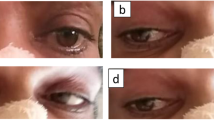Abstract
Background
Occlusion of the intracranial arteries due to blunt head traumas has been less frequently observed in patients with minor head injuries.
Case report
A 4-year-old boy presented with speech disturbance 2 h after minor head injury. An initial computed tomography (CT) scan showed a questionable finding of a focal punctate high density in the left basal ganglia. Hemiparesis developed on the right limbs 8 h post-injury, and a subsequent CT scan revealed a discrete low-density change around the focal high density. Diffusion-weighted images revealed a clearly demarcated high-signal intensity lesion in similar area on T2-weighted and fluid-attenuated inversion recovery sequences images, compatible with infarcted tissues on the territory supplied by the lateral lenticulostriate artery. His hemiparesis improved gradually, and by post-trauma day 10 he was able to walk briefly without assistance. He was discharged on foot at post-trauma day 14.
Discussion and conclusion
Children with minor head trauma who have normal findings on initial CT scan may rarely have basal ganglionic infarction resulting from arterial spasm or thromboembolism of the perforating arteries. Hospital admission and careful observation should be considered for patients with minor head injury and persistent neurologic deficits despite normal CT findings. Magnetic resonance study is valuable for the evaluation of posttraumatic infarction, differentiating from hemorrhagic diffuse axonal injuries.



Similar content being viewed by others
References
Macpherson P, Teasdale E, Dhaker S, Allerdyce G, Galbraith S (1986) The significance of traumatic haematoma in the region of the basal ganglia. J Neurol Neurosurg Psychiatry 49:29–34
De Caro R, Munari PF, Parenti A (1998) Middle cerebral artery thrombosis following blunt head trauma. Clin Neuropathol 17:1–5
Debehnke DJ, Singer JI (1991) Vertebrobasilar occlusion following minor trauma in an 8-year-old boy. Am J Emerg Med 9:49–51
Kelkar AS, Karande S, Chaudhary V, Kulkarni MV (2002) Traumatic posterior cerebral artery occlusion in a 14-month-old child. Pediatr Neurol 27:147–149
Mirvis SE, Wolf AL, Numaguchi Y, Corradino G, Joslyn JN (1990) Posttraumatic cerebral infarction diagnosed by CT: prevalence, origin, and outcome. AJNR Am J Neuroradiol 11:355–360
Oshiro S, Ohnishi H, Ohta M, Tsuchimochi H (2003) Pediatric blunt carotid injury—case report. Neurol Med Chir (Tokyo) 43:134–137
Fujioka M, Maeda Y, Okuchi K, Kagoshima T, Taoka T (1999) Secondary change in the substantia nigra induced by incomplete infarct and minor hemorrhage in the basal ganglia due to traumatic middle cerebral arterial dissection. Stroke 30:1975–1977
Martin NA, Doberstein C, Zane C, Caron MJ, Thomas K, Becker DP (1992) Posttraumatic cerebral arterial spasm: transcranial Doppler ultrasound, cerebral blood flow, and angiographic findings. J Neurosurg 77:575–583
Dharker SR, Mittal RS, Bhargava N (1993) Ischemic lesions in basal ganglia in children after minor head injury. Neurosurgery 33:863–865
Endo M, Ichikawa F, Miyasaka Y, Yada K, Ohwada T (1991) Capsular and thalamic infarction caused by tentorial herniation subsequent to head trauma. Neuroradiology 33:296–299
Okuno T, Takao T, Ito M, Konishi Y, Mikawa H, Nakano Y (1980) Infarction of the internal capsule in children. J Comput Assist Tomogr 4:770–774
Kuroiwa T, Tanabe H, Takatsuka H, Arai M, Ozaki T, Nagasawa S, Ohta T (1994) Paramedian thalamic infarction following blunt head injury–case report. Neurol Med Chir (Tokyo) 34:20–22
Caplan LR, Schmahmann JD, Kase CS, Feldmann E, Baquis G, Greenberg JP, Gorelick PB, Helgason C, Hier DB (1990) Caudate infarcts. Arch Neurol 47:133–143
Perkins CJ, Kahya E, Roque CT, Roche PE, Newman GC (2001) Fluid-attenuated inversion recovery and diffusion- and perfusion-weighted MRI abnormalities in 117 consecutive patients with stroke symptoms. Stroke 32:2774–2781
Ritzl A, Meisel S, Wittsack HJ, Fink GR, Siebler M, Modder U, Seitz RJ (2004) Development of brain infarct volume as assessed by magnetic resonance imaging (MRI): follow–up of diffusion-weighted MRI lesions. J Magn Reson Imaging 20:201–207
Author information
Authors and Affiliations
Corresponding author
Rights and permissions
About this article
Cite this article
Ahn, J.Y., Han, I.B., Chung, Y.S. et al. Posttraumatic infarction in the territory supplied by the lateral lenticulostriate artery after minor head injury. Childs Nerv Syst 22, 1493–1496 (2006). https://doi.org/10.1007/s00381-006-0157-9
Received:
Published:
Issue Date:
DOI: https://doi.org/10.1007/s00381-006-0157-9




